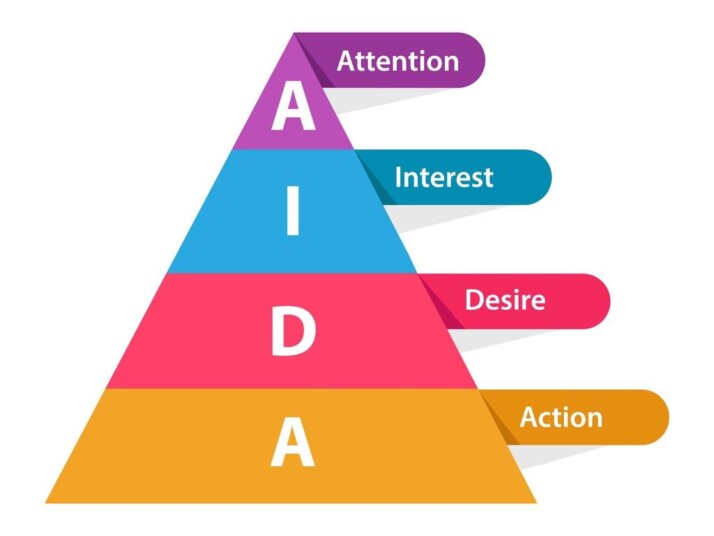The AIDA (Attention, Interest, Desire, and Action) model is a marketing, sales, and advertising model that defines the stages of a consumer’s purchasing journey. Companies base their marketing strategy on the marketing AIDA model and utilize it in digital marketing, public relations campaigns, and sales strategies.
Marketers use the marketing AIDA model when planning their marketing communications strategy. It helps them nurture potential customers during the decision-making process. This guide discusses the AIDA model and how it works.
What is the AIDA Model?
The marketing AIDA model stands for Attention, Interest, Decision, and Action. It identifies the stages a consumer goes through during the buying process. The model is often used in advertising and marketing, where the first stage of the purchase journey is at the top of the funnel.
Here’s a brief overview of the AIDA Model.
- Attention. The consumer must first be aware of a product or service. The offering must also grab the customer’s attention. This is done by luring them in with a catchy title and quick detail about the offering.
- Interest. There needs to be a lot of interest-grabbing content that helps the customer understand the benefits of the product. This interest should encourage the consumer to do further research about the offering.
- Desire. Once the customer is interested in your product, the marketer needs to create a desire in them through an emotional connection. Move the buyer from just liking the product to wanting it.
- Action. Motivate the buyer to take action and interact with your business by including a call to action. For example, engaging in live chat, signing up for a newsletter, or making a phone call.
The Marketing AIDA Model
The AIDA model guides advertisers and marketers through the stages of a consumer’s buying journey.
An understanding of the AIDA model helps the marketer better reach their audience and convince them to achieve their end goal: make a purchase.
Stage 1: Attention
In the first stage of the AIDA model, the marketer uses a creatively disruptive approach to attract the consumer. This approach entails breaking existing patterns of behavior through a highly creative message.
The attention stage of AIDA is crucial – it is unwise to assume that your audience is already aware of your product. You must take the suitable approach to get the word out about your product or service.
You can do this in a couple of ways:
- Place ads in unexpected places or situations.
- Use provocative imagery to create shock in advertisements.
- Use an intensely targeted message.
Stage 2: Interest
Now that the consumer is aware of the product, keep them interested by providing them with information and details about it. During this stage, the consumer will be motivated to learn more about your offering.
Ensure that the advertising information is easy to understand and has interesting illustrations and subheadings. Focus on conveying only vital messages to your consumers.
Stage 3: Desire
Sometimes, the interest and desire stages happen at the same time. But, an emotional connection needs to be established between the prospect and the brand. As you’re building interest in a product or service, you must help customers understand why they “need” this product or service.
While you provide interesting information on the product, spelling out the product’s benefits is also essential to make the consumer want the product.
You need to use product communication that speaks to consumers’ needs to move them from a place of interest to desire. Show the product in use in different situations and convey its value to the audience.
Stage 4: Action
The final stage of the AIDA model involves getting the prospective customer to initiate action. An advertisement should end with a call to action — a statement designed to get an instant response from the consumer.
The action may be to make a purchase, sign up for a free trial, or share social media content. Whatever it may be, it needs to be precise. If other stages of the AIDA model are properly executed, this last step happens naturally.

To Wrap Up
Whether you’re trying to reach your audience or convince them to make a purchase, engaging people starts with getting their attention. Once you have their attention, your advertisement message should hold their interest.
Communicate the convenience and benefits of your product to your audience, highlight its value, and include a CTA that urges them to take action. No matter the stage you are in the funnel, you need to keep your customer engaged, motivated, and emotionally connected to your brand.
Explore All AIDA model Articles
AIDA Job Advertisement: Writing Effective & Interesting Ads
Writing a winning job advertisement can be challenging. It goes beyond putting a few words together — it’s about attracting…
AIDA Email Model for Effective Marketing
Email marketing is an effective tool for reaching and engaging with your audience. Excellent email content can help build trust,…
Inspiring and Interesting AIDA Advertising Examples
Marketers and creatives in the advertising industry use different approaches to create effective campaigns and communicate their offerings to their…
